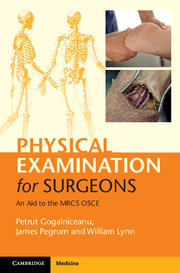Book contents
- Frontmatter
- Dedication
- Contents
- List of contributors
- Introduction
- Acknowledgments
- List of abbreviations
- Section 1 Principles of surgery
- Section 2 General surgery
- 3 Examination of peripheral stigmata of disease in general surgery
- 4 Examination of the abdomen
- 5 Examination of abdominal scars
- 6 Examination of the groin
- 7 Examination of a stoma
- 8 Renal access and transplant examination
- Section 3 Breast surgery
- Section 4 Pelvis and perineum
- Section 5 Orthopaedic surgery
- Section 6 Vascular surgery
- Section 7 Heart and thorax
- Section 8 Head and neck surgery
- Section 9 Neurosurgery
- Section 10 Plastic surgery
- Section 11 Surgical radiology
- Section 12 Airway, trauma and critical care
- Index
4 - Examination of the abdomen
from Section 2 - General surgery
Published online by Cambridge University Press: 05 July 2015
- Frontmatter
- Dedication
- Contents
- List of contributors
- Introduction
- Acknowledgments
- List of abbreviations
- Section 1 Principles of surgery
- Section 2 General surgery
- 3 Examination of peripheral stigmata of disease in general surgery
- 4 Examination of the abdomen
- 5 Examination of abdominal scars
- 6 Examination of the groin
- 7 Examination of a stoma
- 8 Renal access and transplant examination
- Section 3 Breast surgery
- Section 4 Pelvis and perineum
- Section 5 Orthopaedic surgery
- Section 6 Vascular surgery
- Section 7 Heart and thorax
- Section 8 Head and neck surgery
- Section 9 Neurosurgery
- Section 10 Plastic surgery
- Section 11 Surgical radiology
- Section 12 Airway, trauma and critical care
- Index
Summary
Checklist
WIPER
Physiological parameters
• Check peripheries for stigmata of abdominal disease.
Inspection
• Skin: scars, stomas, sinuses/fistulas, distended veins, drains
Ask patient to cough. Observe for pain, peritoneal irritation, hernias or musculoskeletal pain.
• Abdominal wall: hernias (cough + head-up + heels off bed): inspect ventral abdominal wall, umbilicus, groins and scars
• Abdominal cavity: distension, pulsations, masses, visible peristalsis
• Flanks: scars, flank bulges
Ask patient to lean forward. Inspect for hernias as patient strains.
• Back: scars, sacral oedema, pressure ulceration
• Ankles: peripheral oedema, calf swelling
Palpation
Kneel and look at patient's face to identify discomfort during palpation
• Light palpation, four quadrants: identify peritonitis, distension, musculoskeletal pain (use four fingers of one hand).
• Deep palpation, nine regions: identify masses, organomegaly, rebound tendernes , guarding (use two hands).
• Liver, gallbladder and spleen → on inspiration
• Kidneys → ballot with two hands
• Aorta → lateral to medial palpation with two hands
• Scars: incisional hernias → cough
• Groins: inguinal and femoral hernias, inguinal lymph nodes → cough
• Scrotum
• Lower ribs and pelvis
• Specific abdominal signs (see table on pages 49 – 50)
Percussion
• Percussion tenderness: peritoneal irritation
• Ascites: dullness in flanks, shifting dullness, fluid thrill
• Liver size, spleen size
• Palpable bladder
Auscultation
• Bowel sounds
• Abdominal aortic aneurysm bruit
• Renal artery stenosis bruit
• Liver/splenic bruits
To complete the examination…
• Digital rectal examination
• External genitalia
• Urine dipstick
Examination notes
The examination of the abdomen is a broad screening examination that may lead to a focused assessment of other systems. It remains the trademark examination of the general surgeon. A systematic anatomical approach is needed to provide an authoritative opinion.
The examination of the abdomen can be structured around three anatomical layers: skin, abdominal wall and abdominal content.
- Type
- Chapter
- Information
- Physical Examination for SurgeonsAn Aid to the MRCS OSCE, pp. 34 - 60Publisher: Cambridge University PressPrint publication year: 2015



